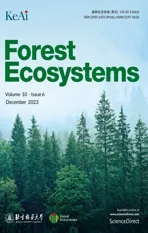Tree-based ecosystem services supply and multifunctionality of church forests and their agricultural matrix near Lake Tana, Ethiopia
2024-01-22FrhiwotMqunintToisFrmoutDidrikStruAlmyhuWssiShimlisAynlmEnywAdoJnNyssnAmuryFrnklLuLnsBrtMuys
Frhiwot Mqunint, Tois Frmout, Didrik Stru, Almyhu Wssi,Shimlis Aynlm, Enyw Ado, Jn Nyssn, Amury Frnkl,h, Lu Lns, Brt Muys
a Department of Wildlife and Ecotourism Management, Bahir Dar University, Bahir Dar, Ethiopia
b Terrestrial Ecology Unit, Ghent University, Ghent, Belgium
c Division Forest, Nature, and Landscape, KU Leuven, Leuven, Belgium
d Alliance Biodiversity International - CIAT, Lima, Peru
e Organization for Rehabilitation and Development in Amhara, Bahir Dar, Ethiopia
f Department of Natural Resource Management, Bahir Dar University, Bahir Dar, Ethiopia
g Department of Geography, Ghent University, Ghent, Belgium
h INRAE, AMAP, IRD, CIRAD, CNRS, University Montpellier, Bld de La Lironde, 34398, Montpellier Cedex 5, France
Keywords:Church forest Remnant forest Provisioning service Regulating service Cultural service Multifunctionality Key informant interview Agricultural matrix
ABSTRACT Ecosystem services (ES) are the connection between nature and society, and are essential for the well-being of local communities that depend on them.In Ethiopia, church forests and the surrounding agricultural matrix supply numerous ES.However,the ES delivered by both land use types have not yet been assessed simultaneously.Here we surveyed both church forests and their agricultural matrices, aiming to quantify, compare and unravel the drivers underlying tree-based ES supply, density and multifunctionality.We found that almost all church forests and half of the agricultural matrices provided high ES densities.ES multifunctionality was higher in the agricultural matrices, suggesting that people deliberately conserve or plant multifunctional tree species.Furthermore,the supply of all categories of ES was positively correlated with church forest age(p-value <0.001)in the agricultural matrix, while the extent of church forest was positively correlated with the density of all categories ecosystem services score in the church forests (p-value <0.001).Our results can be used to prioritize conservation efforts at sites that provide high levels of ES supply, ES density and ES multifunctionality, and to prioritize restoration efforts at sites with low levels thereof.
1.Introduction
Ecosystem services (ES) are the benefits from biodiversity and ecosystem functions in natural and human-modified ecosystems through which human life is sustained(Millennium Ecosystem Assessment,2005;Brown et al.,2014;Díaz et al.,2015).In many developing countries,the day-to-day activities of local communities depend highly on the products and services delivered by local ecosystems(Carpenter et al.,2006;Ango et al.,2014; Dorresteijn et al.,2017;Shumi et al.,2021).
In Ethiopia,church forests are remnant native forests of variable size(i.e.1-100 ha) surrounding churches, protected mainly for religious reasons(Wassie et al.,2010;Klepeis et al.,2016;Mequanint et al.,2020,2022).Located around some of the oldest churches in the world(Wassie et al.,2005),these forests are among the last natural forest fragments in the country (Wassie et al., 2009, 2010; Cardelús et al., 2013; Reynolds et al., 2015; Aerts et al., 2016; Mequanint et al., 2020).They deliver a wide variety of ES, including provisioning (e.g., fodder, medicine),regulating(e.g.,soil conservation,pest control),and cultural(e.g.,places for worship and religious festivals) ES (Wassie et al., 2009, 2010; Aerts et al., 2016; Amare et al., 2016; Klepeis et al., 2016).Local populations are dependent on these forest fragments since their livelihood is either directly or indirectly linked to these ES.However, rapidly growing demands for ES have been undermined due to resource degradation (Klepeis et al.,2016).While church forests have been remarkably resilient on the landscape (Scull et al., 2017), land use pressure has caused the surrounding agricultural matrix to lose much of its original woody vegetation(Frankl et al.,2019).
Scattered trees in the agricultural matrix surrounding church forest relics have a determinant effect on the ES availability in the landscape(Fig.1).These agricultural matrix trees increase the connectivity between the remnant natural forest fragments,provide‘stepping stones’for local fauna,thereby promoting seed dispersal and natural regeneration of trees(Haddad,1999;Berggren et al.,2002;Castell′on and Sieving,2006;Mequanint et al., 2020) and reduce runoff and erosion (Amsalu and de Graaff, 2006; Frankl et al., 2019).Moreover,scattered trees in the agricultural matrix provide a way to restore the landscape (Eshete, 2007),and to safeguard species threatened by local extinction such as overexploited medicinal plant species(Mequanint et al.,2020).
Previous research has often focused on individual ES(Gamfeldt et al.,2013), but the day-to-day livelihoods of local people depend on woody plant species that provide multiple ES simultaneously (Tolessa et al.,2017; Shumi et al., 2021).Moreover, studying individual services in relationship to their drivers is challenging due to the multidimensional nature of ecosystems and trade-offs or synergies between ES (Manning et al., 2018).For example, Lee and Lautenbach (2016) found that tradeoffs were dominant between regulating and provisioning ES,whereas synergies were primarily observed between regulating and cultural ES.Similarly,ES delivery might depend on interactions between multiple ecosystem services or functions(i.e.multifunctionality)(Byrnes et al.,2014;Manning et al.,2018).Therefore,holistically measuring ES by including different categories(provisioning,regulating,and cultural),ES multifunctionality and their interactions are important for conserving biodiversity and the benefits it provides to humans in the long term.Similarly,spatially mapping ES delivered to local communities is vital to prioritize conservation and restoration actions, to create awareness on how to capitalize on the synergies and/or to reduce the trade-offs between ES.However,previous research on church forests in Ethiopia has usually focused on floristic components, with limited attention to the delivery of ES, although understanding the relationships between biodiversity and ES has become a major field of research(Peterson et al.,1998; Isbell et al., 2011; Cardinale et al., 2012).Moreover, no studies have simultaneously assessed the ES delivered by church forests and their agricultural matrix, although this is essential to understand the ES delivered at a landscape level.It is also important to understand how the ES provided by church forests and agricultural matrices relate to each other: e.g., do they provide similar levels of ES, or do they tend to compensate for each other?
This study aimed to understand the potential of tree-based ES and ES multifunctionality in church forests in comparison to their agricultural matrix.To obtain data on the potential ES provided by tree species, we carried out key informant interviews, and weighed these data with the abundance of the tree species in the church forests and their agricultural matrix, following Tekalign et al.(2017).Our two objectives and corresponding hypotheses were as follows.First, we aimed to quantify and compare ES supply, which is the total ES score of each church forest ES multiplied by its species abundance and total area, ES density (i.e.ES supply per unit of area), and ES multifunctionality between church forests and their agricultural matrix.We thereby hypothesized that (i) ES supply is higher in the agricultural matrix than from church forests since the agricultural matrix covers a much larger area,(ii)ES density is higher in the church forests than in the agricultural matrix, thanks to the long-term traditional church forest conservation and management, and(iii)ES multifunctionality is higher in the agricultural matrix because the remnant trees in the agricultural matrix have undergone more selective conservation or establishment by local farmers than the trees in the church forests.Second, we aimed to identify the historical and geographical drivers underlying spatial variation in ES supply, ES density, and the ratio between them.As to this second objective, we hypothesized that the agricultural matrix surrounding the oldest church forests provides a higher ES supply than those surrounding more recently established church forests.The matrix of old church forests might have developed large trees and tree populations that reflect long-standing cultural traditions and provide resources for local communities, and habitats for forest fauna.In addition, seed dispersal from these church forests could be higher, since seed availability might be high in these church forests.In addition,we hypothesized that ES densities would be higher in larger church forests because of their higher species richness.With our results,we contribute to developing better and more integrated socio-ecological management strategies for landscapes consisting of church forests and their surrounding agricultural matrices.
2.Materials and methods
2.1.Study area
Our study area is located in the southeastern part of the Lake Tana Basin in the lower ranges of the highlands of northwestern Ethiopia,between Bahir Dar and Debre Tabor, with an elevation between 1,800 and 2,200 m a.s.l.Land cover types include cropland,human settlements,natural forest fragments, bushland, plantation forest, water bodies,wetland, and grassland (Song et al., 2018).The area experiences a strongly seasonal rainfall regime (about 70%-90% of the total rainfall occurs during June-September), while temperature seasonality is low(Peel et al., 2007).Average annual rainfall ranges from 1,250 to 1,500 mm and the mean annual temperature ranges between 15.3°C and 19.6°C(Lemma et al.,2018).South Gondar Administrative zone in which the study area exists has 1,404 church forests (Wassie et al., 2010) (Supplementary Material Fig.S1),of which this study focuses on those close to the east part of Lake Tana(11°39′-11°56′N and 37°27′-37°55′E),an area containing a total of 134 church forests.Woody vegetation cover in the agricultural land is on average 5.5% in the Lake Tana Basin (Frankl et al.,2019).
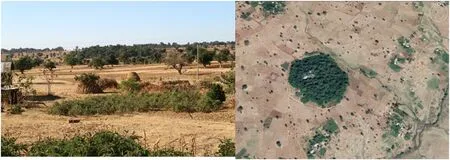
Fig.1.Church forest surrounded by an agricultural matrix of scattered trees in south Gonder, Ethiopia (11°44′47.576′′ N and 37°30′25.841′′ E).Photograph (2021,left) and satellite image (right) (satellite image ©2021 Maxar Technologies-Google Earth).
2.2.Focal church forests and agricultural matrices
From the total of 134 church forests, 24 church forests (hereafter‘focal church forests’) were selected based on accessibility, distance between the consecutive church forests (a minimum of 4 km), and maximizing the variation of the surrounding matrix in the radius of 3 km(Fig.2) (Mequanint et al., 2022).The agricultural matrix surrounding each church forest was delineated using Thiessen polygons (Supplementary Material Fig.S2) and vegetation was sampled from each agricultural matrix.The extent of the focal church forests ranged from 2 to 13 ha,while the extent of the agriculture matrices surrounding the focal church forests ranged from 682 to 2,484 ha(Table 1).The focal churches in the forests were established between 340 and 2010 A.D.(EOTC,n.d.).However, according to personal communication with church forest priests, three focal church forests were destroyed due to war and reestablished in recent years (Kirekus in 1983, Kudese Minas in 2004 and Tiwaz Abo in 2010).
2.3.Data collection
2.3.1.Vegetation sampling
In each church forest, four 20 m × 20 m plots were sampled with a total of 96 plots.Plots were established in the four cardinal directions(north,east,west,south), but on different distances along the axis from church to edge.The starting direction was selected randomly and continued in a clockwise direction (Fig.3).Methodological details and results on the vegetation composition can be found in Mequanint et al.(2020).In each agricultural matrix, eight line transects were sampled around each of the focal church forests.These transects were laid out in the north, north-east, east, south-east, south, south-west, west, and north-west directions(Fig.3),each time starting at the edge of the church forest.The transect length was 1 km and the width of the transects was 10 m.All tree species in these line transects were identified,counted,and measured.Diameter at breast height (DBH) and height were measured using a diameter tape and ‘Nikon Forest Pro’ rangefinder, respectively.When the height of the plant was greater than 1.6 m,DBH was measured at 1.3 m above ground level.For trees containing buttressed stems, the DBH was measured above the buttress and for multiple stems, all stems were counted and measured (Wassie et al., 2010).Identification was carried out the species level following Bekele-Tesemma (2007).Species that were difficult to identify were identified in the National Herbarium(herbarium code ETH).Plant nomenclature used in this article is based on the published guidelines of the Flora of Ethiopia and Eritrea,Vol.1-8(1989-2009)(Edwards,1997;Edwards et al.,1995,1997;Hedberg et al.,2003).The recently updated nomenclature for Acacia spp.was also used(Kyalangalilwa et al.,2013).
2.3.2.Ecosystem services
Information about potential ES provided by local tree species was collected through interviews of 22 key informants (3 from Fogera district,3 from Bahir Dar Zuriya district,12 from Dera district,and 4 from Bahir Dar University).These informants were all knowledgeable on the topic, including officials from the Bureau of Agriculture, plant conservation experts, village officers, rural development agents, and researchers specialized in botany or forestry.The body of the questionnaire was constructed using a matrix structure where each informant could indicate the ES provided by each species in the study region,always in a dichotomic way (provided/not provided).In total, 28 potential treerelated ES were used in the questionnaire (Table 2), based on literature(Bekele-Tesemma,2007;Seyoum and Teketay,2015)and expert opinion(Tekalign et al.,2017).Informants had the option to add non-listed ES as well.
2.3.3.Historical and geographical variables
Information on the presence or absence of a protecting stone wall around the church forest (this permanent fence is expected to protect seedlings against cattle), year of church forest establishment (possibly related to the age of the agricultural use of the matrix and the time since fragmentation of the forest), church forest extent (related to the risk of extinction), agriculture matrix extent, number of households within the agricultural matrix, and distance to the nearest permanent road (i.e.a publicly maintained road suitable for 4-wheel vehicles) were used as explanatory variables(see Mequanint et al.,2020 for details)to assess the drivers behind the ES provided by the church forests and their agricultural matrices.
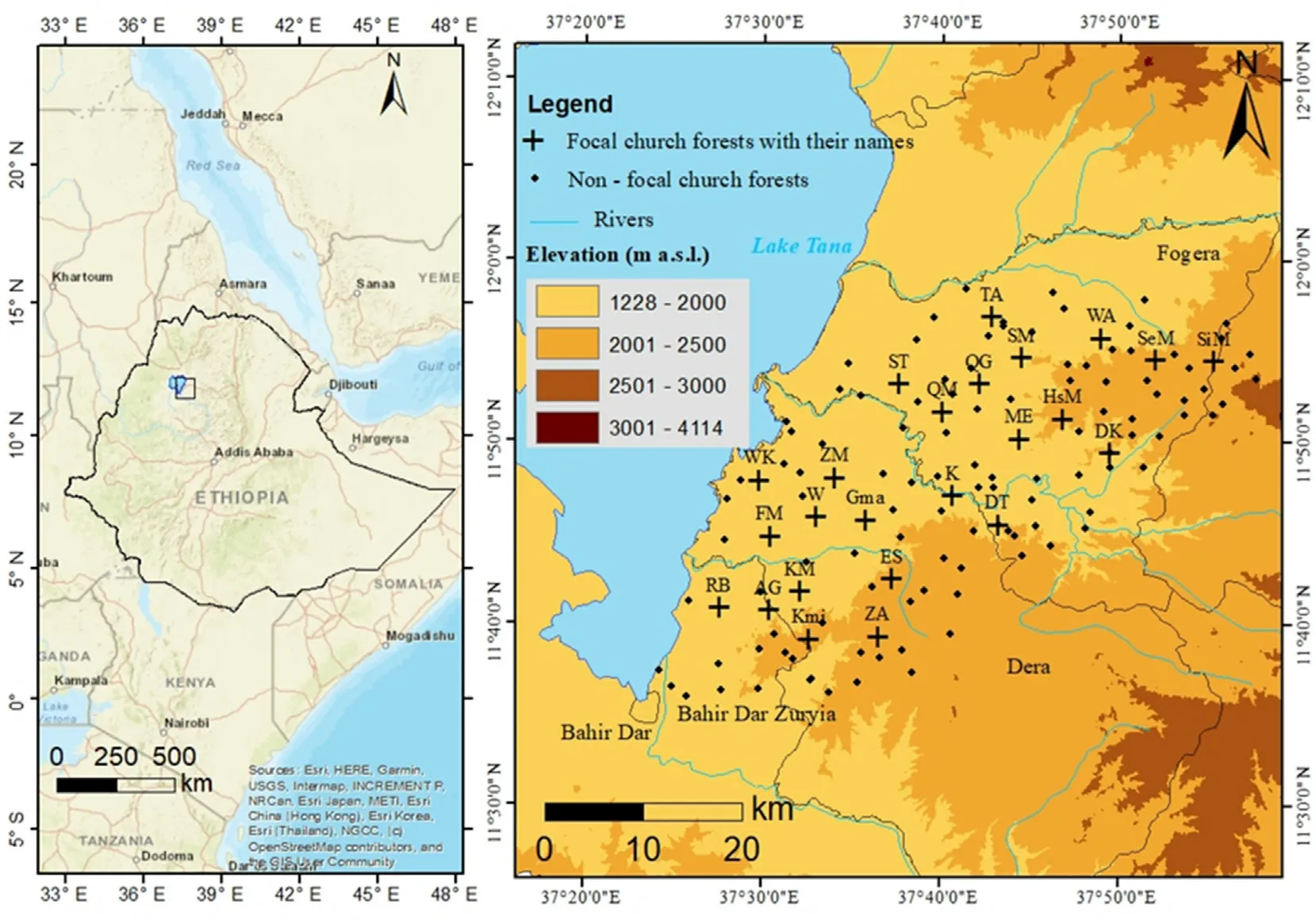
Fig.2.Map of the study region southeast of Lake Tana showing the 24 selected focal church forests(black crosses,the full names of the focal church forest are listed in Table 1) and non-focal church forests (black dots).
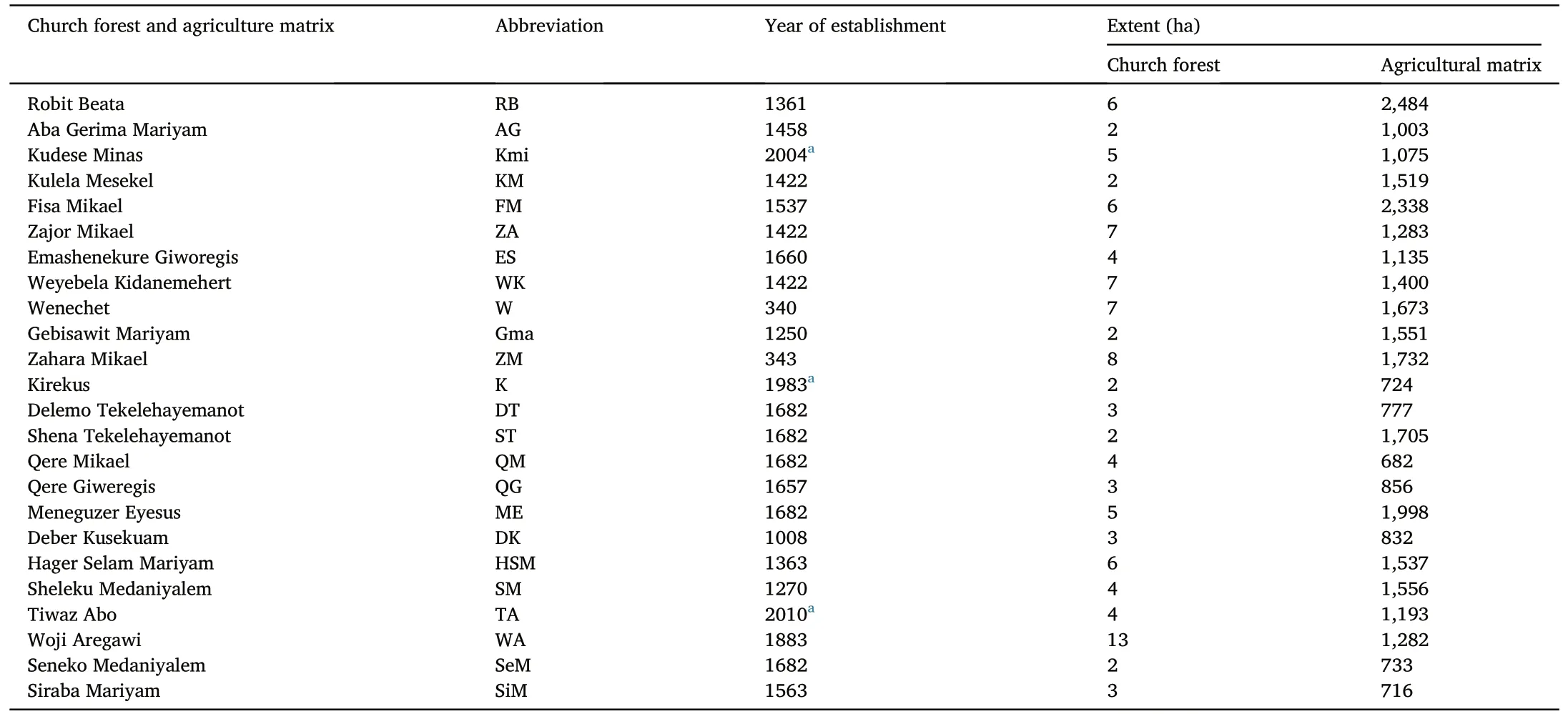
Table 1List of the 24 focal church forests with their names,abbreviations,year of establishment,as well as the extent of the church forests,and their corresponding agricultural matrices.Church forests are listed from south to north.
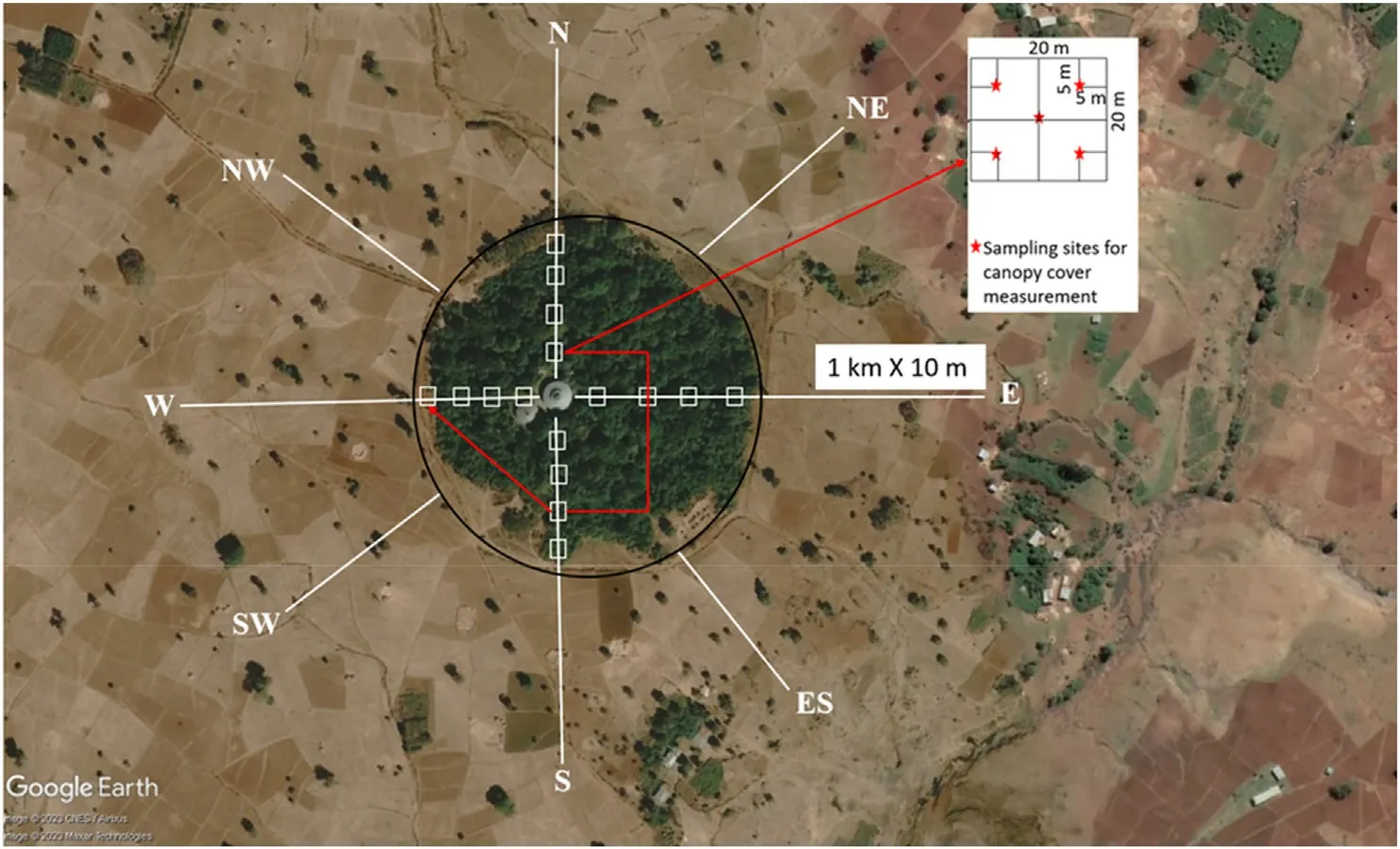
Fig.3.Sampling and survey design in northwest Ethiopia church forest.This Google Earth image captures the distinct church forest of northwest Ethiopia,forming protective rings around historic churches (latitude: 11°44′47.84′′ N, longitude:37°30′26.84′′ E).To assess woody species and seedling abundance, a systematic approach was employed.Four sampling plots were strategically selected in the cardinal directions (north, east,west,south),at varying distances from the church buildings to the compound's edge.Starting direction was chosen randomly and proceeded clockwise.Each sampling plot measured 20 m ×20 m, with 5 m × 5 m plots in each corner for seedling counts.For the agriculture matrix eight transects (north, north-east, east, south-east,south, south-west, west, and north-west), each 1 km in length and 10 m width,5 m on each side of the central transect line, were used to identify tree species, assess their abundance, and gather data on their size, including diameter at breast height and height (Figure not to scale).
2.4.Data analysis
2.4.1.Quantification of ecosystem service supply, density, and multifunctionality
The analysis of the questionnaire data was adapted from Tekalign et al.(2017).The results of the 22 key informant interviews were combined into a binary matrix indicating the potential ES scores for each species based on the proportion of key informants that mentioned the specific potential tree-related ES.When the proportion of informants mentioning an ES for a specific species was lower than 0.15,the ES score of that species was set to 0,to avoid the inclusion of mistakes or ES that are only very rarely used.When larger than 0.15, it was set to 1, hence assuming that the species does provide the ES in question.This binary score was then cross-checked with information found in the literature to construct the final potential tree-related ES matrix for all encountered species (‘species ES matrix’).Subsequently, the species ES matrix of church forests and surrounding matrices was estimated by weighting the species-specific ES scores with the site-specific species abundances (i.e.the ES score of species was multiplied by its abundance at each site)and summing these per site(see details in Supplementary Material Table S1).For example,if 11 out of 22 respondents mentioned that Cordia africana provides firewood, the proportion of informants for this ES species combination is 0.5.As this is larger than 0.15, Cordia africana was assigned an ES score for firewood of 1.Next,to calculate the ES score of Cordia africana in a specific church forest or agricultural matrix, this value of 1 was multiplied by the abundance of Cordia africana in that forest or matrix.After calculating the ES scores for all species using the same procedure,we summed the ES scores of all species per site,resulting in the total ES supply score per site.This ES supply was then also divided by the surface area of each church forest and agricultural matrix to obtain their respective ES density.There was no strong effect of tree size (i.e.basal area) on ES production, possibly due the fact that big trees were rarely found in most sites(results not shown).In total,four site-specific ES matrices were thus obtained: (i) church forest ES supply (i.e.total ES score multiplied by its species abundance and total area), (ii) agricultural matrix ES supply,(iii)church forest ES density(i.e.ES supply per hectare of church forest),and(iv)agricultural matrix ES density.Further,these supply and density matrices were used to calculate two ratio matrices: the ES supply ratio (church forest ES supply divided by agricultural matrix ES supply) and the ES density ratio (church forest ES density divided by agricultural matrix ES density) matrices.All these indices and matrices were constructed for individual ES, as well as for provisioning, regulating, cultural and total ES grouped together, using the ES classification of Millennium Ecosystem Assessment (2005) (see Table 2) and summing the ES scores in each of these categories.The ES density of each church forest (X) was standardized using this formula,and then, the ES multifunctionality of church forests and their agricultural matrices was quantified by averaging the density matrices of the different ES (Byrnes et al., 2014).The total ES supply,total ES density and ES multifunctionality scores for each church forest and agricultural matrix were visualized in maps using ArcMap 10.The total ES supply, ES density and ES multifunctionality scores(y-axis)were plotted for each site.
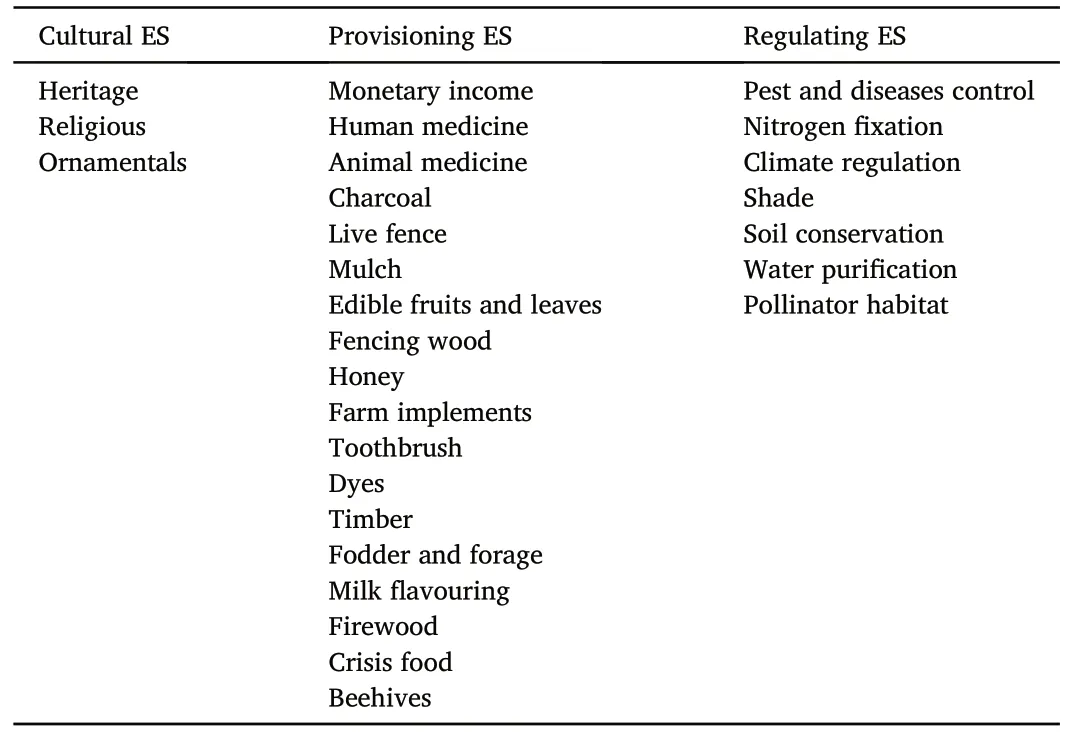
Table 2Tree-related ecosystem services (ES) are considered in this study.ES are categorized according to the Millennium Ecosystem Assessment (2005).
2.4.2.Comparison of ecosystem service supply, density and multifunctionality between church forests and their agricultural matrix
To compare the ES supply, ES density and ES multifunctionality between church forests and their agricultural matrices, we carried out pairwise t-tests.To explore relationships between the ES provided by church forests and the agricultural matrix, we carried out Pearson correlation tests,using the mean values of each ES categories(i.e.cultural,provisioning,regulating, total and multifunctional) for each church forest and agricultural matrix.
2.4.3.Historical and geographical factors behind the provision of ES and ES multifunctionality
To identify the historical and geographical factors behind the ES supply, ES density, ES supply ratio, ES density ratio and ES multifunctionality of the church forests and their agricultural matrices, we carried out generalized linear models (GLM) with a Gaussian error structure, specifying the different ES categories (i.e.cultural, provisioning, regulating and total ES and ES multifunctionality) as dependent variables, and the three patch and three landscape variables described above as explanatory variables.Inference was based on a full model containing all six explanatory variables, and variables were deemed significant when having a p-value ≤0.05.Normality of the residuals was checked using Shapiro-Wilk tests and normal QQ-plots.The dependent and independent variables were first standardized by subtracting the mean and dividing by the standard deviation.The regression model runs using the total score(i.e.the total number of individual trees)of each ES(i.e.cultural, provisioning, regulating and total ES and ES multifunctionality) as a dependent variable.We run the regression model separately for church forests and agricultural matrices since they are different land use system.Moreover, the establishment years of three church forests were not included because those churches were only reestablished recently and the original date of establishment(i.e.the age of the church forest)is unknown.Similarly,the extent of church forests and their agricultural matrices were excluded in the ES supply and ES supply ratio models since these response variables are area-based thus inclusion in the model as a separate independent variable would bias our results.
3.Results
3.1.Potential tree-based ES and ES multifunctionality
The site-specific ES density, displayed in Fig.4, shows which treerelated ES are abundantly or poorly provided in church forests and their matrices.In terms of ES density,religion,honey,fencing wood,soil conservation, climate regulation, pollinator habitat, and water purification were the most important ES available in the church forests, while human medicine and nitrogen fixation were the most important ES of the agricultural matrix.When examining the patterns in panels of Fig.4a and b, we can observe a vertical dark gray pattern in Fig.4a and a more horizontal light gray pattern in Fig.4b.The vertical pattern in Fig.4a suggests that there were a number of tree-related ecosystem services that are systematically well-provided across nearly all church forests(except at Gebisawit Mariyam (Gma) and Hager Selam Mariyam (HSM) church forests).The horizontal pattern in Fig.4b suggests that there were a number of agricultural matrices that had a systematically low potential of tree-related ecosystem services, also indicating considerable differences in ES density between different agricultural matrices.
The three church forests with highest total ES supply were Woji Aregawi (WA), Weyebela Kidanemehert (WK) and Zahara Mikael (ZM)church forests,while Wenechet(W),Robit Beata(RB)and Zahara Mikael(ZM)were the agricultural matrices with highest total ES supply(Fig.5).Likewise,the three church forests with highest total ES density were Woji Aregawi (WA), Weyebela Kidanemehert (WK) and Zajor Mikael (ZA),while the agricultural matrices of Wenechet (W), Delemo Tekelehayemanot (DT) and Deber Kusekuam (DK) provided the highest total ES density(Fig.6).The multifunctionality values of the agriculture matrices were similar throughout the study area,except for a few sites,while the multifunctionality values of the church forests varied among sites with a slightly increasing trend from south to north(Fig.7).
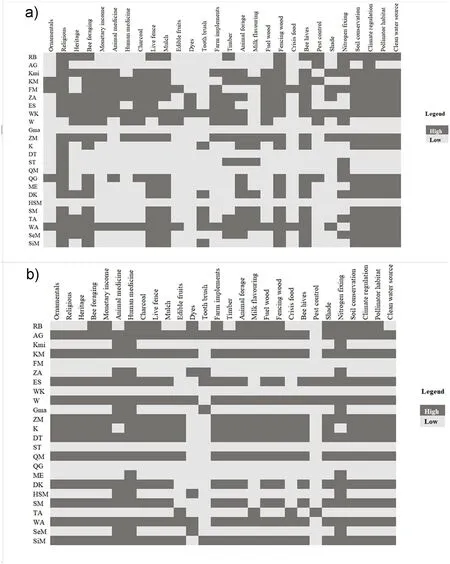
Fig.4.ES density matrices for church forests (panel a) and agriculture matrices (panel b).Dark gray indicates high tree-related ES density, light gray indicates low density.The threshold between the two shades was 0.23.Site names are listed in rows and tree-related ES in columns (see full names of the sites in Table 1).
3.2.Comparison of ecosystem service supply, density and multifunctionality between church forests and agricultural matrices
Considering total ES supply,the church forests provided lower levels of cultural (mean ± standard error: 3.38 ± 0.07), provisioning (3.31 ±0.08), regulating (3.26 ± 0.07) and total (3.31 ± 0.08) ES than the agricultural matrices(3.89±0.04,3.77±0.04,3.80±0.04 and 3.79±0.04, respectively).The differences were significant (t-value, p-value:6.12, <0.001; 5.19, <0.001; 6.71, <0.001 and 5.66, <0.001, respectively,Supplementary Material Table S2).We observed no evidence of a correlation between the total ES supply of church forests and agricultural matrices for each of the ES types(Fig.8).
Considering ES density, the church forests provided higher levels of cultural(mean±standard error:661.28±66.90),provisioning(2.72±0.05), regulating (499.96 ± 44.05) and total ES (584.96 ± 64.05) than the agricultural matrix(7.13±0.74,0.68±0.04,5.85±0.59 and 5.70±0.58,respectively).These differences were significant(t-value,p-value:9.75, <0.001; 5.20, <0.001; 11.17, <0.001 and 9.03, <0.001, respectively,Supplementary Material Table S2).We also observed no evidence of correlation in each ES categories between church forest ES and the agricultural matrix ES (Fig.9).
The t-tests indicated that the ES multifunctionality of the church forests (0.51 ± 0.02) was significantly lower (p <0.001) than for the agricultural matrices(0.71 ±0.00)(Supplementary Material Table S2).
3.3.Historical and geographical factors behind the provision of ES and ES multifunctionality
Table 3 presents the results of the generalized linear models to evaluate which historical and geographical factors can be used to predict the delivery of ES in the church forest and the agricultural matrices,using the different ES categories under the ES supply, ES density, ES supply ratio and ES density ratio as dependent variables.

Fig.5.ES supply score of the focal church forests and agricultural matrices.Green color indicates the church forests and red color the agricultural matrices(see full names of the sites in Table 1).(For interpretation of the references to color in this figure legend, the reader is referred to the Web version of this article.)

Fig.6.ES density score of the focal church forests and agricultural matrices.Green color indicates the church forests and red color the agricultural matrices(see full names of the sites in Table 1).(For interpretation of the references to color in this figure legend, the reader is referred to the Web version of this article.)
The model indicates that the density of all ES categories(i.e.cultural,provisioning, regulating and total ES) in the church forests were positively correlated to the church forests extent.On the other hand, the supply of all ES categories in the agricultural matrix correlated positively with the age of church forest(Table 3).When considering ES density,all ES categories in the agricultural matrix correlated positively with the age of church forest and the presence of a stone wall around the church forest, while correlated negatively with the agricultural matrix extent(Table 3).Both the church forest and the agricultural matrix ES multifunctionality were not significantly related with any independent variables(Table 3).
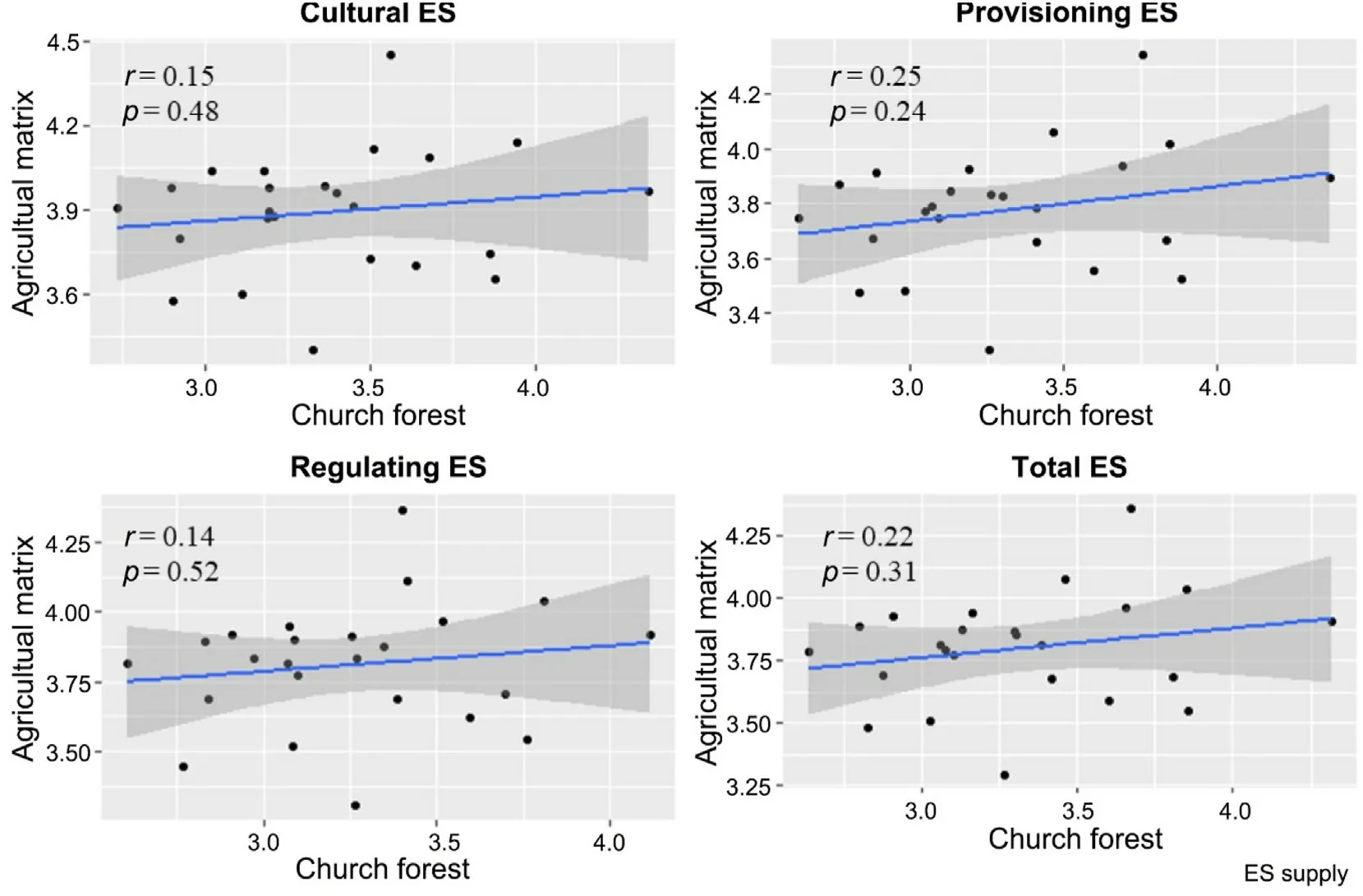
Fig.8.Relationships between ES supply of church forests and agricultural matrices considering the ES supply to see if they do provide similar levels of ES,or they tend to compensate for each other.
The ES supply ratio of all ES categories (i.e.cultural, provisioning,regulating and total ES)correlated positively with the presence of stone wall around the church forest, while the ES density ratio, only the cultural and regulating ES correlated positively with the age of church forest when allowing a 90% confidence interval (Table 3).Remarkably, we found no significant trend between ES supply,or ES density with number of households within the agricultural matrix and distance to the nearest permanent road(Table 3).
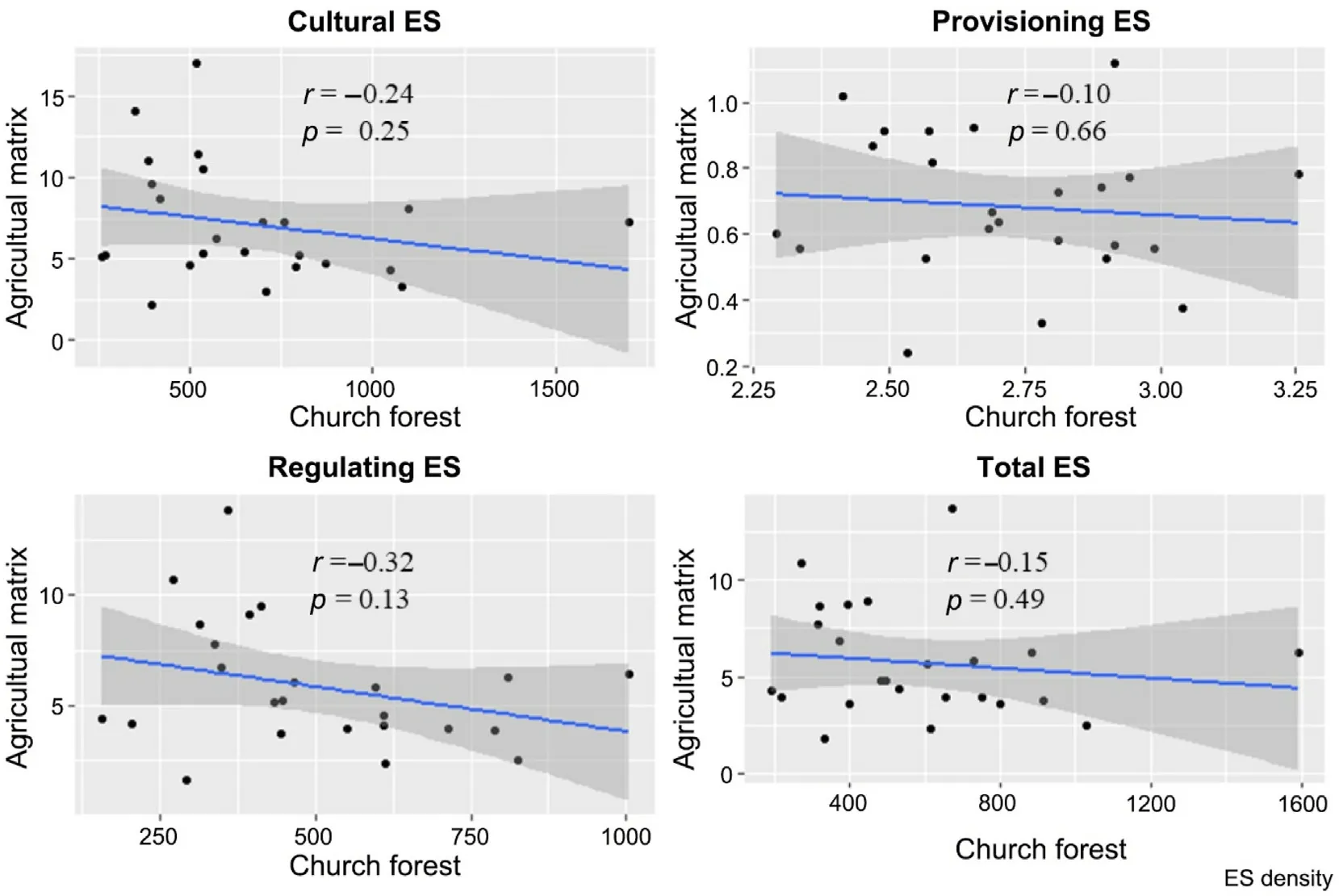
Fig.9.Relationships between the ES density of church forests and agricultural matrices.
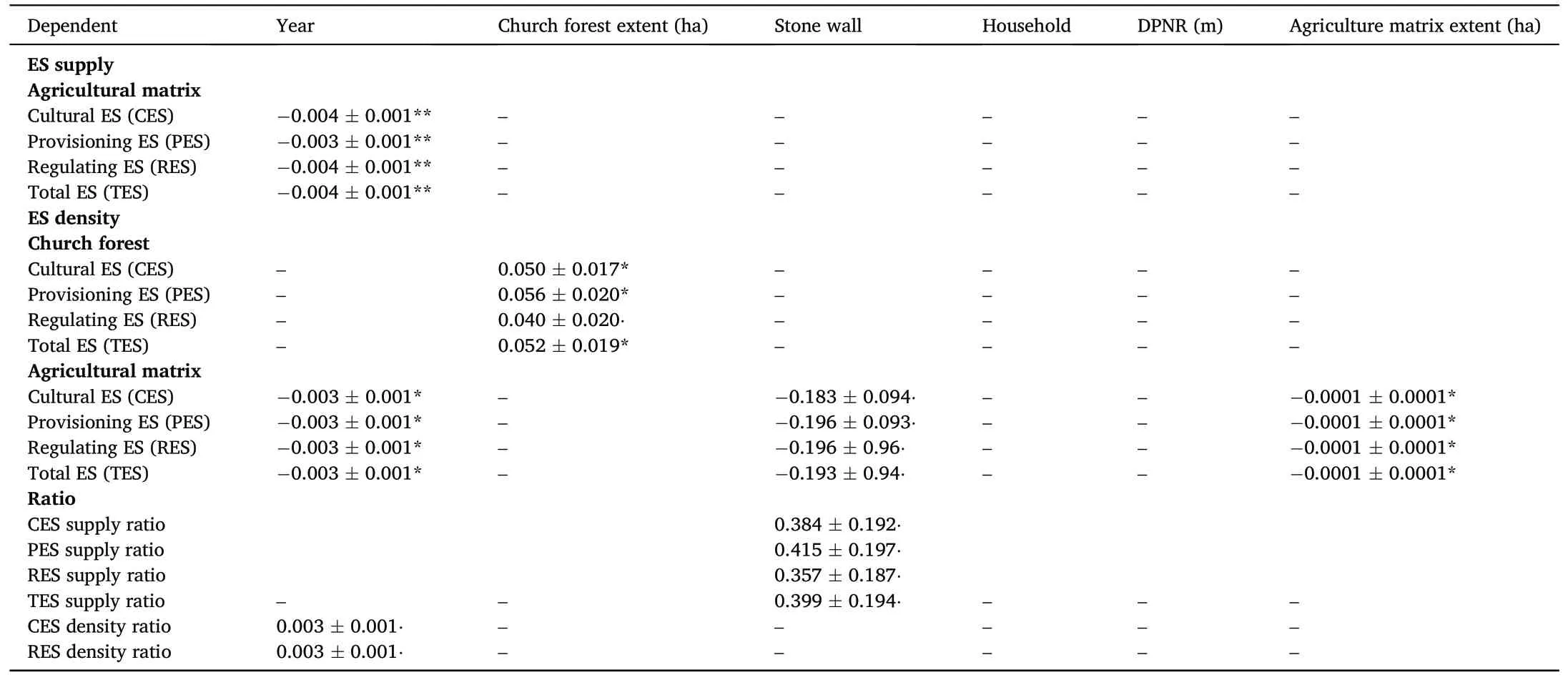
Table 3Results of the generalized linear models evaluating the relationship between the ecosystem services delivered by church forests and their agricultural matrices and historical and geographical factors.The values shown are the estimate,standard error and p-value.The dependent variables are listed in the rows and the explanatory variables in the columns.Abbreviations for the explanatory variables:year of church forest establishment(Year),church forest extent,number of households within the agricultural matrix, distance to the nearest permanent road (DPNR), presence or absence of a stone wall around the church forest and agriculture matrix extent.Inference was based on a full model containing all six explanatory variables, and variables were deemed significant when having a p-value ≤0.05.The significance levels: p-value <0.001 ‘***’,p-value <0.01 ‘**’, p-value <0.05 ‘*’and p-value <0.1 ‘·’.
4.Discussion
4.1.Ecosystem services and multifunctionality
Our results showed that almost all of the focal church forests deliver a high ES density, as compared to half of the corresponding agricultural matrices.Religious ES, fencing wood, soil conservation, climate regulation,pollinator habitat,water purification are the most important ES(in terms of ES density)delivered by church forests,while human medicine and nitrogen fixation were most important in the agricultural matrices.These potential ES are important for the daily lives of the local communities either spiritually or economically.The religious services were also the primary reason for the conservation of the church forests.This might be because the trees inside the church forest create a tranquility and peaceful place for monks and hermits(“menagn”)seeking isolation,and locals also believe that “menagn” inhabit in the forests around the churches, hence each tree provides religious services.In line with these findings,Klepeis et al.(2016)and Orlowska and Klepeis(2018)reported that local communities protect church forests primarily because of non-material benefits and religious services.The next most important ES is soil conservation.As shown by Frankl et al.(2019),past societies may have allowed vegetation regrowth in specific locations in the landscape in order to improve soil conservation.
In the agricultural matrix, nitrogen fixation was the most important ES in terms of ES density.Soil nitrogen deficiency is a common problem in the study area(Haileslassie et al.,2005).Farmers often cannot afford to buy mineral nitrogen fertilizers, and therefore purposely conserve or protect natural regrowth or nitrogen fixing plants in their farmlands as a cheaper way of increasing the amount of nitrogen available to crops.Our results confirmed the findings of Munroe and Isaac(2014)and Thijs et al.(2015), who also reported that conserving nitrogen fixing plants on farmlands is a common practice to address soil nitrogen deficiency.Similarly, the value of medicinal plants to the local communities made human medicine the next most important ES in the agricultural matrix.According to Garedew and Bizuayehu (2018), most Ethiopians are dependent on traditional plant medicine rather than modern medicines.For instance Croton macrostachyus Del.,the most abundant tree species in the agriculture matrix, is used for malaria and liver treatments, healing wounds, and several other medicinal uses (Abera, 2014; Garedew and Bizuayehu, 2018).Similarly, Cordia africana Lam.is used for healing wounds,treatment of diarrhea,eye infection and several other medicinal uses (Teklay et al., 2013).However, not all medicinal species were abundant: Mequanint et al.(2020) reported that several medicinal species are facing local extinction due to overexploitation,a problem which is partly caused by the fact that the roots are the most frequently utilized plant part,followed by the leaves(Garedew and Bizuayehu,2018).
4.2.Comparing the ecosystem services and multifunctionality of church forests and the agricultural matrices
Consistent with our hypothesis,the ES supply of agricultural matrices was larger than the ES supply in church forests, as the agriculture matrices cover a much larger area.Therefore, it is crucial to maintain scattered trees in the agriculture matrix to provide ES to local communities.In addition, these scattered trees serve as ‘stepping stones’ between church forests and hence increase the level of landscape connectivity for local fauna (Abiyu et al., 2016; Aerts et al., 2016), and they also improve the beauty of the landscape for recreational activities.
Contrary to ES supply, our results indicated that church forests provide higher ES densities than their agricultural matrices,thanks to longterm traditional forest conservation and management,which has resulted in higher tree density and species richness in forests than in the surrounding agricultural matrices.Our findings confirmed this hypothesis,in line with other studies (e.g.Gamfeldt et al., 2013; Brockerhoff et al.,2017;Valdés et al.,2020;Shumi et al.,2021)that showed a high quantity of ES in natural forests,driven by high tree species richness and density.Moreover, the presence of a diverse set of tree species increased the provision of ES compared to communities with fewer species (Lefcheck et al.,2015),this might be due to diverse species assemblages being more resistant to disturbance, increasing the number of pollinators and also facilitating carbon sequestration that leads to enhanced ecosystem functioning (Sintayehu et al., 2020; Muluneh et al., 2021; Wondimu et al.,2021).Similarly,Balvanera et al.(2006)found clear evidence that biodiversity has positive effects on the delivery of most ES.
Our findings confirmed our hypothesis that the agricultural matrix provides higher ES multifunctionality than church forests, suggesting that local communities deliberately conserve or plant multifunctional species on their farmland.In line with this,Jiren et al.(2017)found that many local communities in southwestern Ethiopia favored multifunctionality-oriented land management systems.Similarly,Valdés et al.(2020)reported that,across ancient Europe,ancient woodlands in the agricultural matrix are characterized by high ES multifunctionality.Thus, preserving scattered trees is important to increase the multifunctionality of the agricultural matrix.Therefore, enhancing the conservation of scattered forest patches in the agricultural matrix will not only improve church forest connectivity,facilitate landscape restoration,and provide additional habitat and resources, but also improve soil fertility, treat diseases, and diversify agricultural inputs.In alignment with this study,Manning et al.(2006)studied the ecological significance of scattered trees in diverse landscapes, revealing them as keystone structures that provide critical functions,from microclimate regulation to genetic connectivity and ecosystem restoration support.Therefore, the tradition that the local community deliberately conserves multifunctional trees in their farming land should be encouraged and supported.In this way, the ecological function of forest areas is expanded without potentially impacting the livelihoods of local people.This would enable the wide acceptance of the intended management option by the local people.However, tree species selection and planting activities with farmers in the matrix should be done carefully to avoid negative impacts since we noted that in recent times communities are increasingly using exotic multifunctional species (e.g., Grevillea robusta) to boost the multifunctionality of the matrix, especially in degraded matrices, where remnant native trees have become scarce.Exotic species plantation in well-conserved natural forests should be prohibited.With proper management managed,exotic species can be used where there is the need to fill degraded gaps or enlarge the forests.As such,they serve not only an income source but also as pioneer nurseries for the recovery of shade requiring native species.
4.3.Historical and geographical drivers of ecosystem services delivery
Understanding the drivers behind the provision of ES can improve our ability to sustainably manage landscapes to provide multiple ES.In this study we found that agricultural matrices surrounding older church forests provide higher levels of ES supply than those surrounding more recently established church forests.Two reasons could be drawn for this result:firstly,due to the presence of larger trees in older church forests,which serve as more effective seed sources, promoting the natural regeneration of species in the surrounding matrix; secondly, due to the higher presence of trees with large basal area in the agricultural matrix closer to older church forests (Supplementary Material Fig.S3).Trees with a large basal area have more structural complexity and provide habitats for various species,serve as shade for animals and humans,and are more resistant and resilient to disturbances (Lindenmayer and Laurance,2017),even though the density of such trees is generally low.Hence, thanks to their large basal area, such species provided services and thus have significant ecological importance(Mequanint et al.,2022).In addition, they can also provide vital social values, as large trees are culturally and spiritually important in Ethiopia (Orlowska and Klepeis,2018).In addition,we found that larger church forests provide higher ES densities than smaller church forests.This might be due to the fact that larger church forests have higher species richness than smaller church forests(Mequanint et al.,2020).Similar findings by Valdés et al.(2020)from 224 woodlands distributed across temperate Europe support the fact that larger forests host more species and are expected to have a higher potential for ES.
4.4.Conservation implications
Our results indicated that local communities deliberately conserve multipurpose trees in their farmlands,hence this is an important activity to increase the ES multifunctionality of the agricultural matrix.Thus,our findings advocate for the conservation of scattered indigenous trees in the agricultural matrix in the support of agricultural production at the regional as well as national level.Further, we recorded higher ES densities in the church forests than in the agricultural matrices.Church forest are crucial for the delivery of ES because of their rich biodiversity,long history of traditional conservation and also wide distribution of the church forests in the region.
An important finding of our study was that large church forests and agricultural matrices surrounding older church forests provide higher ES densities,thus these sites urgently need conservation.Understanding the trade-offs and the synergies between ES, including the spatial and temporal interactions among ES and management intervention, are important to sustainable conserve the natural resources in the study region.While we expected that the local communities attempt to compensate the lower delivery of ES in church forests by retaining more trees in the agricultural matrix and vice versa,the observed correlations between the ES supply and density of church forests and agricultural matrices, both for specific ES types and total ES,were not statistically significant.These results could suggest that church forests and agricultural matrices are managed relatively independent from each other.
While scattered trees in the agricultural matrix can serve as stepping stones for local fauna,the small size and the island-like distribution of the church forests poses risks for the genetic diversity of the tree species populations present in these forests (Aerts et al., 2016).Increasing the size of these forests and,if possible,establishing corridors between them,should therefore be encouraged.
Overall, our findings confirmed that both church forest as well as scattered trees in the agricultural matrix provide important ecosystem services to local communities, underlining the importance of raising awareness about the role of church forests and agricultural matrices in the provision of ES.Our study illustrated that conservationists,foresters,and policy makers should conserve biodiversity in the region in a holistic way, considering the entire landscape rather than only focusing on the remaining forest fragments.We stress the importance of halting the further degradation of woody vegetation in the agricultural matrix and relying on indigenous knowledge for land rehabilitation.
Ethics approval and consent to participate
Not applicable.
Consent for publication
Not applicable.
Availability of data and material
The datasets used and/or analysed during the current study are available from the corresponding author on reasonable request.
Funding
This study received financial support from VLIR-UOS, Belgium through the VLIR-IUC Interuniversity cooperation with Bahir Dar University, Ethiopia (BDU-IUC).The funding body do not have any role in the design of the study and collection,analysis,and interpretation of data and in writing the manuscript.
CRediT authorship contribution statement
Ferehiwot Mequanint:Conceptualization, Writing - original draft,Writing-review&editing,Formal analysis.Tobias Fremout:Writingreview & editing.Diederik Strubbe:Writing - review & editing, Supervision.Alemayehu Wassie:Conceptualization,Supervision,Writing- review & editing.Shimelis Aynalem:Conceptualization, Writing -review&editing,Supervision.Enyew Adgo:Writing-review&editing.Jan Nyssen:Writing - review & editing.Amaury Frankl:Writing -review & editing.Luc Lens:Conceptualization, Supervision, Writing -review&editing.Bart Muys:Conceptualization,Supervision,Writingreview& editing.
Declaration of competing interest
The authors declare that they have no competing interests.
Acknowledgments
We are grateful to all EOTC priests for access to the church forests,local communities for their willingness to access their farmlands.We would also like to express our deep gratitude to all higher officials, experts, officers, agents and researchers from the three districts for providing the necessary information and field assistance.
Appendix A.Supplementary data
Supplementary data to this article can be found online at https://doi.i.org/10.1016/j.fecs.2023.100145.
杂志排行
Forest Ecosystems的其它文章
- Divergent responses of Picea crassifolia Kom.in different forest patches to climate change in the northeastern Tibetan Plateau
- Influence of climate fluctuations on Pinus palustris growth and drought resilience
- Nutrient retranslocation strategies associated with dieback of Pinus species in a semiarid sandy region of Northeast China
- Book review “Continuous Cover Forestry - Theories, Concepts, and Implementation” by Arne Pommerening
- Impact of black cherry on pedunculate oak vitality in mixed forests:Balancing benefits and concerns
- Sensitivity of forest phenology in China varies with proximity to forest edges
